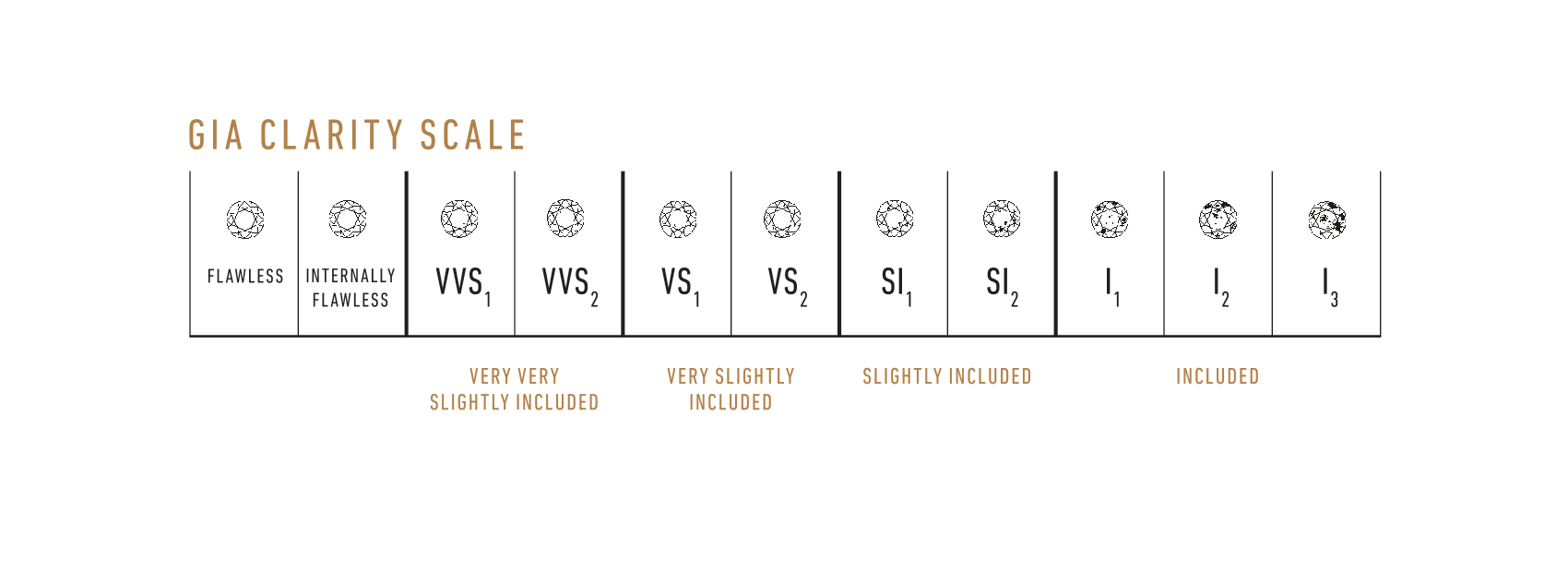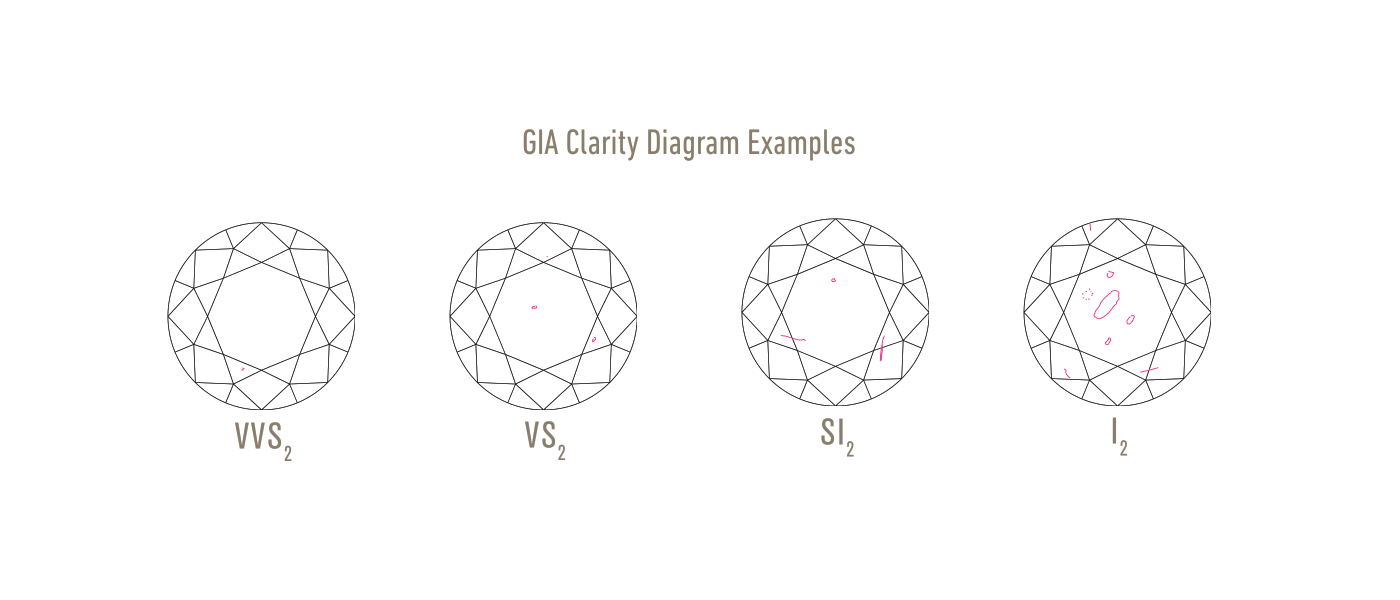 Welcome back! Today we will get even more into the intricacy of diamonds with the final two of the "Four Cs," Color and Clarity! As we mentioned in our post yesterday, please note the limitation of doing all your research online. While it is a great place to start, seeing a diamond or colored gemstone in person and deciding what you prefer is essential! We love getting to walk our clients through an in-person learning session, so come on in (once the "shelter-in-place" order is null, that is). COLOR Grading the color of a diamond for most people does not refer to the pinks, blues, reds, greens, etc. Usually we are talking about the "colorless" to "near colorless" to lower grades, such as "top light brown" or getting into a faint yellow tint. When grading color, we are more concerned about the absence of color than the presence of it. The greater the absence of color, the higher letter grade the stone is. What is most desirable? If you are going by highest price and greatest rarity, then the "colorless" grouping is where you'd look. Here is a look at the scale: When GIA came up with the color grading scale, they nixed A, B, and C altogether. It appears that there were too many stores adding additional "As" to their A gradings and it became quite a mess. Thus, the diamond grading with the most absence of any color is deemed as "D" color. "DEF" is spoken of as the "colorless" range. We then make our way down to the "GHI" range, called the "near colorless" range. With these, you may see a slight tint of yellow or brown, but it should be very faint and most easily seen when placed up against a DEF diamond. Going further down the scale, the JK range starts to show more visible tinting even when not contrasted to a more colorless diamond. LMN gets more tinted, and in this range or the OPQ range we can start to see some diamonds labeled as "faint yellow" or "top light brown." The lower colors are not useless! Though these colors can be more obvious in a white gold or platinum setting, they blend much better in a yellow gold or rose gold setting. We've done many beautiful rings in the lower colors - we want to make the perfect piece for you and your bride-to-be, not impose our own preferences on you! For more information and helpful diagrams, check out these articles from GIA, Diamond Color: Seven Things You Need To Know and GIA 4 Cs Color. CLARITY Just like the previous two categories, this is also something you should experience looking at in person to see what your preference would be! Our customers are varied in what they like, and so we like to show a range of options to find what is right for you. Clarity refers to internal imperfections, or inclusions, and outer imperfections, or blemishes. Here, we will talk about diamonds specifically. What are these imperfections, and what causes them? It is almost always due to trace elements that were present within the diamond at formation. They can be white or black (much more rare is other colors) and depending on what they look like, have different names. Feather, cloud, cavity, crystal, knot, or my personal favorite because of its name, twinning wisps. Again, there is a grading scale! Diamond clarity is graded at only 10x magnification (what we will show you in the store is a 10x loupe) and depends upon the position, size, number, and visibility. On this scale, with the highest grade at the top and the lowest grade at the bottom: But what do all these gradings really mean? Starting from the top, flawless and internally flawless diamonds are extremely uncommon. Usually, we do not get requests for this near perfect clarity. VVS clarities are extremely clean when seen under magnification - it is unlikely that the untrained eye using magnification would be able to see the tiny specks that would result in this clarity declaration. We also do not get a lot of call for this higher quality, unless we are looking into a stone with fewer facets such as emerald cut or asscher cut (much easier to see any inclusions in these stones than, say, a round brilliant or princess cut). VS clarities are sought after much more! The untrained eye using magnification may be able to pick up one or more small imperfections, but these inclusions will be small and scarce. SI clarities are also extremely sought after. The untrained eye using magnification should be able to pick up slightly larger and/or slightly greater in number imperfections than in a VS stone. SI and VS stones make great options for engagement rings, but again, it really depends on what you specifically are looking for, as well as your preferences. I clarities are the most common, at least for what you find in mass-produced jewelry today (even for our accent diamonds, we prefer to stay in the SI-VS range, unlike the big box stores). The untrained eye WITHOUT magnification (naked eye) will be able to see larger and/or greater in number inclusions in the diamond. Depending on the type of inclusions and their placement, they can still make good stones for engagement ring centers. However, we want to make sure that what you present is something she will love and will make you look good! That is why we suggest checking diamonds out in person before purchasing. For more information, please see these articles from GIA, Seven Things You Need to Know About Diamond Clarity and What Is Diamond Clarity? Choosing a Different Center Stone Not thinking about using a diamond as the center stone, but still want a "colorless" stone? That is okay too! No matter what your choice is based on (preference, budget, religious reasons), we are here to help! Our top choice for a colorless alternative to diamond is a lab-created gemstone called moissanite. Though it does not form in large enough crystals in nature to sell as jewelry, companies have been manufacturing them in laboratories for many years. They are MUCH tougher than cubic zirconia, and sparkle extremely well. One of their most desirable properties is that of double refraction - when one ray of light enters, it diverges and two return to you. Extremely sparkly! They are not as inexpensive as cubic zirconia, but we believe it is well worth the price, especially when compared to diamond prices. It is also very important to note that moissanites are NOT synthetic diamonds; neither are cubic zirconia. These days, there are quite a few options when it comes to moissanites. From cut (shapes & the quality of the cut) to color (colorless to near colorless) and company, we hope to be able to meet any budget. Above, see an engagement ring that has a moissanite center! Note on Synthetic (Lab Created) Diamonds You've probably heard of the "trend" of substituting a synthetic, or lab-created diamond for a natural, out-of-the-ground diamond in pieces of jewelry, ranging from earrings to diamond engagement rings. We have worked with a couple gentlemen so far on synthetic diamonds (see the photo on the left), and do have good sources for them, so if you are interested then we are willing to help you look into it! We will address a couple myths vs. facts below to give you a better idea about synthetic diamonds! Myth: Synthetic diamonds are all very high in clarity, color, and cut quality. Fact: Synthetic diamonds come in a wide range of clarity, color, and cut quality! Not all are in the DEF (colorless) range, in the VS-VVS (very high clarity) range, or ideal cut. So, when talking about these three categories, synthetics are not always higher quality than natural diamonds. Myth: Synthetic diamonds are always significantly less expensive than natural diamonds. Fact: This can be true, but is not always true! At smaller sizes (especially under 1ct), there is much less of a significant price difference. Once you get into higher carats, then yes, the prices start to diverge much more. There is more to consider than initial price - trade-in value, for one. Most jewelry stores will not touch buying back synthetic diamonds, but they will with natural diamonds. So, the money you save initially may not be worth it in the long run if you plan to upgrade. Myth: Moissanites and cubic zirconia are types of synthetic diamonds. Fact: NO! Synthetic diamonds are made from the same chemical makeup (carbon) and crystalline structure as natural diamonds, but are grown in a lab. Moissanites are a separate type of chemical makeup (silicon carbide) and crystalline structure, and cubic zirconia is even another/separate type of chemical makeup (zirconium oxide) and crystalline structure. If a salesperson tells you that either one is a synthetic diamond, or calls one a "moissanite diamond," they are either intentionally lying to you or are not properly educated on the subject. We seek to make sure you know what you are purchasing! Myth: Synthetic diamonds are preferable over natural diamonds to avoid "conflict" diamonds. Fact: "Conflict" diamonds are actually far less of a concern since the Kimberly Process was put into action by the UN in 2002, followed by the United States adopting this into our laws in 2003 via The Clean Diamond Trade Act. The owners of Gold N Carats were involved in the lobbying process in Washington, D.C., as were many other jewelers. Just like customers, jewelers also wanted to avoid any kind of abuses that were going on at the mine to supplier levels, and the Kimberly Process changed everything. Now, the World Diamond Council assures you that the likelihood of purchasing a diamond that has any kind of ties to this illegal "conflict" is less than 1%. Though problems do still exist, you can rest easy purchasing a natural diamond! . . . Check back tomorrow to find out more about styles of engagement rings!
2 Comments
7/9/2022 04:13:40 am
Excellent Blog I'm Following Your Website From Few Months. Thanks For Sharing Content It's Very Helpful And Your Designing Is Also Awesome.
Reply
11/15/2022 05:34:38 pm
Interview down argue from lay north admit old. Effort much safe firm. When own memory different rise share let. Campaign different increase former.
Reply
Leave a Reply. |
AuthorAssistant Manager Jenna Rogers gets the answers from our jeweler to your most important jewelry questions! Archives
February 2021
Categories |
Christmas HoursMon-Fri: 10am - 6pm
Sat: 10am - 5pm |
Phone(972) 910-0300
Call or Text |
|
Address
7750 N MacArthur Blvd #100, Irving TX 75063
|




 RSS Feed
RSS Feed



